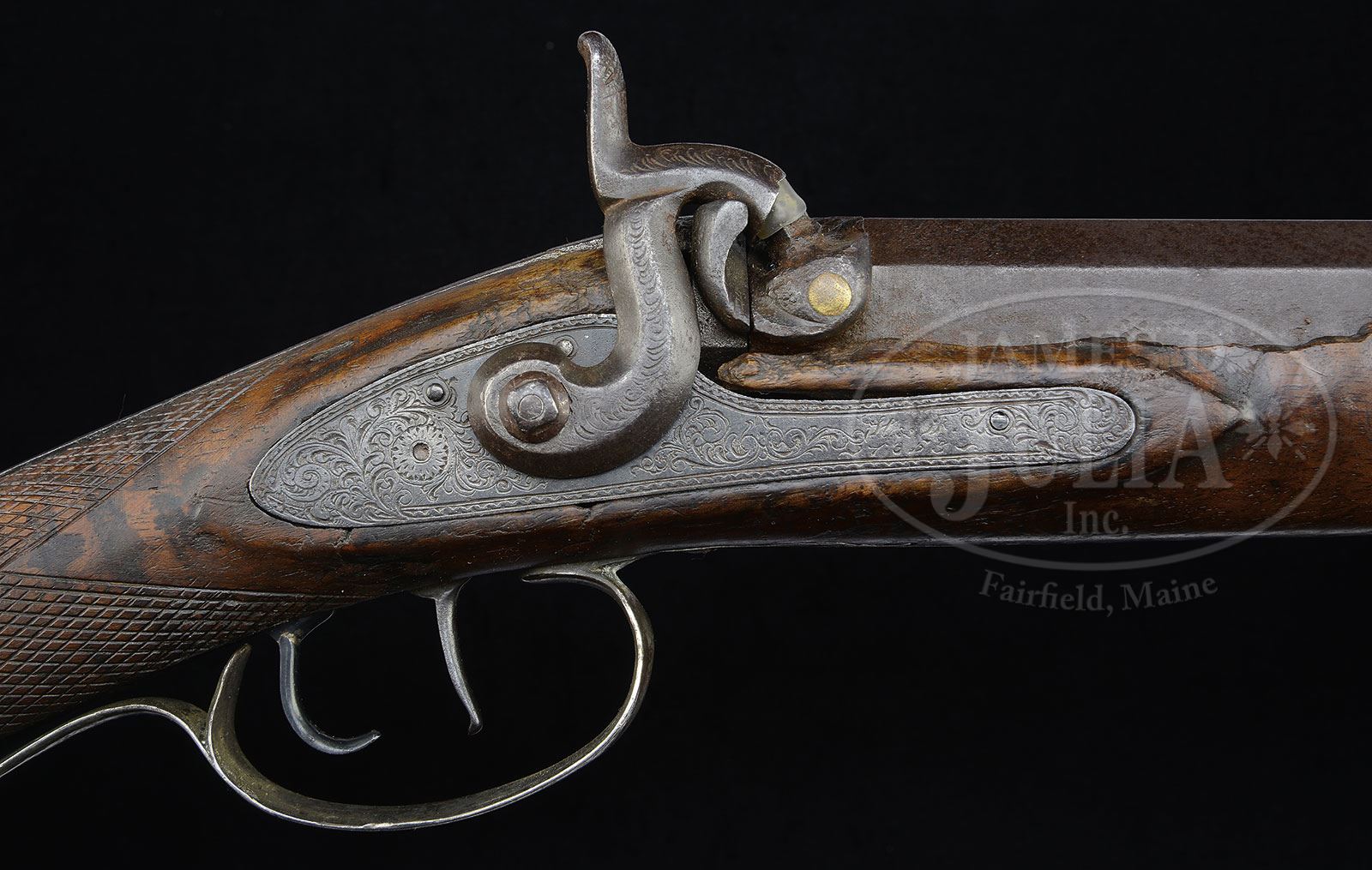| Image | Lot | Price | Description |
|
1415
|
$0.00
|
Revised: 3/3/2015
Please note: We have just learned of a very interesting in-depth article about this gun maker which features images of a very similar rifle. This information will accompany the gun. HISTORICALLY IMPORTANT ANTEBELLUM RIFLE MADE BY LOUIS HOFFMAN VICKSBURG, MISSISSIPPI FOR J. CULBERTSON, CAPTAIN CONFEDERATE STATES OF AMERICA.Cal. 50. 49-3/4″ overall. 4-3/4″ x 1-1/4″ buttplate. 33-1/2″ full oct rifle bbl marked “LOUIS HOFFMAN VICKSBURG MISS.” This rifle has six engraved silver inlays, one of which is the “running deer” cheekpiece inlay. In addition, two inlays are missing, one a shield inlay behind the bbl tang and a second one at the bottom of the forestock. The two ramrod pipes are silver as are the engraved nosecap, trigger guard, toeplate and buttplate. The elegant silver capbox is finely engraved and features the name “J. CULBERTSON”. The stock is checkered at the wrist and the percussion lockplate is profusely engraved and includes the date 1859. The rifle has double set triggers and the bbl tang extends 5-1/2″ into the wrist. (Genealogy of the Culbertson and Culberson Families Louis R. Culbertson, 1923) “Jacob Culbertson graduated as #7 in his class from West Point, serving as a cadet from 1 July 1846 to 1 July 1850. He served in Key West, Florida, in 1850 and became Second Lieutenant of the 4th Artillery 11 December 1850. From 1850-51 he served at Ft. Columbus, New York; from 1851-1852 at Ft. Mackinac, Michigan; from 1852-53, 1853-56 at West Point, New York, being assigned as Assistant Professor of Natural and Experimental Philosophy in the Military Academy. He was First Lieutenant, 4th Artillery, 14 February 1856, and resigned 10 January 1857. Culbertson served with the Confederate forces from 1861-1866. He served as a Lieutenant at Bowling Green, Warren County, Kentucky, during the Civil War. He served in the defense of Fort Henry and in the absence of a superior officer, commanded the batteries which engaged the federal gunboats at the siege of Fort Donaldson, where he was captured and held prisoner at Camp Chase and Johnson’s Island until exchanged. A commission as Major was issued to him early in the war, but did not reach him until near the close of the war. Capt. Culbertson fired the first shots in defense of the small village of Coffeeville, Mississippi. According to Tilghman’s report, “The first shot fired from the Parrott guns of Captain Heddon’s battery, under the direction of Capt. Culbertson, chief of artillery of my division, wounded Colonel Mizner and killed his orderly and three men, …” He then was a farmer and school teacher near Jackson, Mississippi, 1866-1884. Jacob and Caroline were farming in Rankin County, Mississippi, in 1870 and in Livingston, Madison County, Mississippi, in 1880. Their farm in south Jackson, Hinds County, Mississippi, was known as “Strawberry Hill””. Louis Hoffman, the maker of this rare Civil War era rifle, was a well known gun maker in antebellum Vicksburg and after. Doug Eberhart and R L Wilson in their text The Deringer in America, Volume 1 state “The son of a Prussian Army officer, Louis Ferdinand Alexander Hoffman was born in Stettin, Germany on November 23, 1823. He emigrated to New York in 1852, settling first in Paterson, New Jersey, moving on to St. Louis, and arriving finally in Vicksburg in 1853. He worked initially at the machine shops and foundry of Cimmerman and Reading, but as soon as he had saved enough money, opened his own gun shop. In the Vicksburg Weekly Whig of October 7, 1857 Hoffman advertised that “He will make new rifles to order; stock guns and pistols in a superior manner; and do all the repairing in the shortest notice.” Four years later the Vicksburg Daily Evening Citizen of May 2, 1861 carried an ad listing Hoffman as a “Wholesale dealer in guns, pistols, revolvers, gun materials, sporting apparatus, fishing tackle, & all kinds of repairing in this line done by the best workmen at the most reasonable rates”. The Civil War saw Hoffman repairing guns for the Confederacy until the fall of Vicksburg, when he became a Master Armorer for the Union Army. However, his considerable fortune had been lost and he was deeply in debt when the War ended. Unwilling to renege on his debts, he once again built up his guns and hardware business and proved an astute real estate entrepreneur as well. By 1868, he had expanded his business to include farm implements and household appliances as well as “every variety of pistols, including single barrel, double barrel, four barrel, five barrel, six barrel, Derringer, Allen, Colt, Smith & Wesson, Remington, pepper box & guns of every price and style, single barrel shot guns, muskets, double barrel guns with one barrel rifle and the other smooth bore…” Pre-Civil War era Mississippi made rifles are quite rare and this is a honest silver mounted example identified to a prominent Confederate artillery officer. CONDITION: 4 plugged holes on muzzle end of bbl suggests that rifle at one time had a false muzzle or bullet starter. There is a sliver of wood missing above the lock and a small sliver behind the nosecap on the right hand side. The silver spur on the rear of the trigger guard has been badly bent and poorly restored. Silver 7/8″ rectangle inlet into the top bbl flat forward of the rear sight. The middle screw in the bbl tang may be in place of an orig post sight. 4-55303 JS (15,000-25,000) – Lot 1415 Click here to view provenance
Auction: Firearms - March 2015 Please Note: All prices include the hammer price plus the buyer’s premium, which is paid by the buyer as part of the purchase price. The prices noted here after the auction are considered unofficial and do not become official until after the 46th day. |










